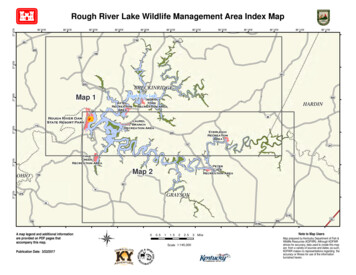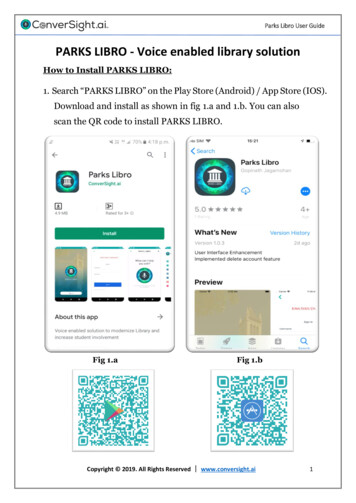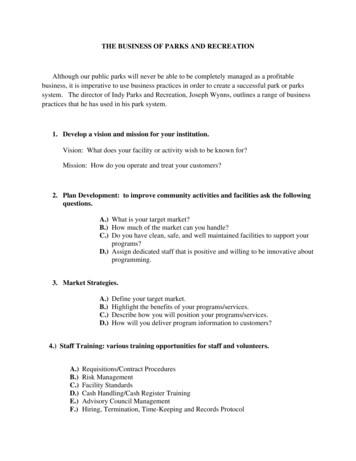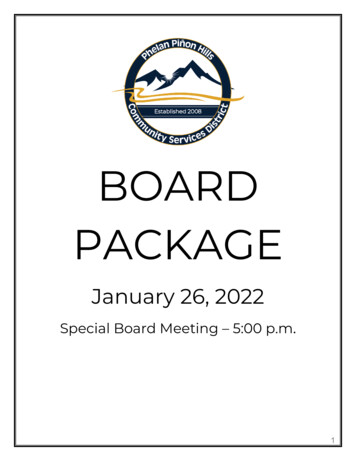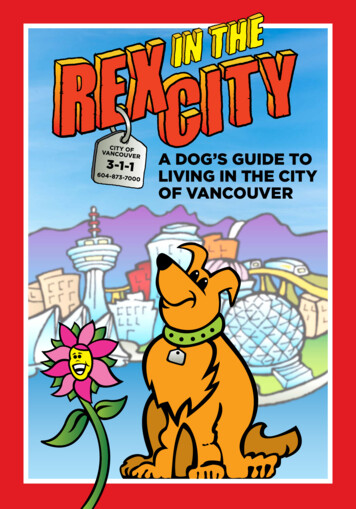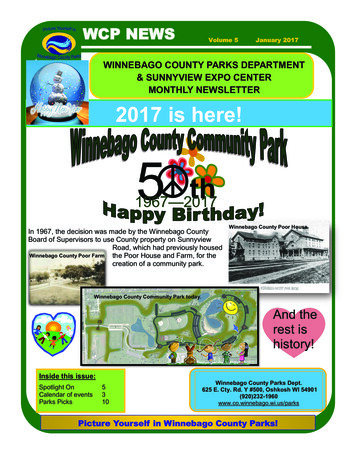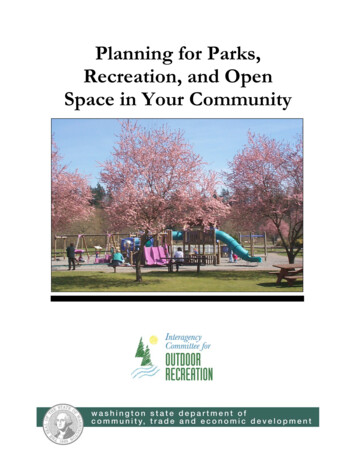
Transcription
Planning for Parks,Recreation, and OpenSpace in Your Community1
Planning for Parks, Recreation, andOpen Space in Your CommunityWashington State Department of Community, Tradeand Economic DevelopmentInteragency Committee forOutdoor RecreationCTED STAFFJuli Wilkerson, DirectorLocal Government DivisionNancy K. Ousley, Assistant DirectorGrowth Management ServicesLeonard Bauer, AICP, Managing DirectorRita R. Robison, AICP, Senior PlannerJan Unwin, Office Support SupervisorPO Box 42525Olympia, Washington 98504-2525(360) 725-3000 Fax (360) 753-2950www.cted.wa.gov/growthIAC STAFFLorinda Anderson, Recreation PlannerJim Eychander, Recreation PlannerText bySusan C. Enger, AICPMunicipal Research & Services CenterSeattle, WashingtonFebruary 2005
Photo CreditsCTED/Rita R. Robison, cover and pages 1, 3, 7, 14, 15, 16, 18, 32, 34, 35, 37, 39, 46, 57, 61,64, 66, 68, 74, 79, 80, 86Mark Fry, page 5Courtesy of the City of Tigard, page 10Interagency Committee for Outdoor Recreation, page 20Courtesy of the City of Stanwood, page 22Courtesy of the City of Puyallup, page 33Courtesy of the City of Vancouver, page 71Courtesy of the City of Snohomish, page 76Courtesy of Metro Parks Tacoma, page 91
Table of ContentsIntroduction. 1GMA Provisions and Case Law Relating to Parks, Recreation, and Open Space. 5Building an Integrated Open Space System. 12Different Open Space Types and Purposes. 14Hazardous Critical Areas . 14Ecologically Critical Areas . 15Commercially Significant Resource Lands . 16Recreation, Education, and Cultural Sites . 17Lands That Shape Urban Form . 18Lands With Aesthetic Values Defining Community Identify. 18Urban Reserves or Future Urban Areas . 19Parks, Recreation, and Open Space Planning Processes. 20Step 1: Consider Goals and Overall Planning Framework . 21Step 2: Initiate Community Visioning and Ongoing Citizen Participation . 21Step 3: Inventory Existing Conditions, Trends, and Resources/Identify Problems andOpportunities. 24Step 4: Develop Goals and Priorities to Guide Parks, Recreation, and Open SpaceMeasures . 28Step 5: Enlist the Support of Other Local Groups, Jurisdictions, and Departments. 31Step 6: Assess Parks/Open Space/Recreation Needs and Demand . 37Step 7: Develop Site Selection Criteria and Priorities, Based on Community Goals. 56Step 8: Evaluate Plan Alternatives; Select and Adopt the Preferred Plan . 56Step 9: Prepare the Parks, Recreation, and Open Space Plan Element. 57Step 10: Develop Tools to Implement Your Parks, Recreation, and Open Space Strategy . 59Step 11: Adopt and Transmit the Element. 59Open Space Designation Criteria. 61Criteria Must Be Tied to Local Objectives . 61Different Types of Criteria Can Aid the Decision Process. 61Structure Sets of Criteria to Focus Selection Decisions . 62Open Space Protection Techniques . 64Be Prepared to Apply a Variety of Tools to Address a Variety of Purposes. 64Decide on a Balance of Regulatory and Nonregulatory Approaches . 64Build a Program that Combines Public and Private Protection Efforts . 69Select the Tools Best Matched to the Job and Local Conditions. 70Issues in Designating Open Space Areas. 71Economic Issues. 71Access Issues . 73
Maintenance/Stewardship . 74Legal and Political Considerations . 76Park Design Issues/Planning Parks for People . 78Address Needs of Different Population Groups . 79Open Space Corridors . 81Funding for Parks and Recreation (Or You Must Pay to Play) . 84Traditional Local Funding Sources Authorized by Statutes . 85Several Newer Funding Sources Adopted as a Part of GMA Legislation. 85Federal and State Funding Programs . 86Interlocal Cooperation . 87Alternative Approaches for Providing Park and Recreation Services . 87Special Purpose Districts . 89Conclusion . 92Appendix A:Appendix B:Appendix C:Appendix D:Appendix E:Appendix F:Appendix G:Appendix H:Appendix I:User Demand and Park Use Survey ExamplesPark Inventory ExamplesComparison of Recreational DistrictsInterlocal Agreements ExamplesIAC Recreation and Habitat GrantsCity of Bellevue Summary of Funding ResourcesReferences and ResourcesResources for ADA AssistanceOnline Resources for Parks, Recreation, and Open Space PlanningTable of FiguresFigure 1.Figure 2.Figure 3.Figure 4.Participation in General Recreation Categories as a Percent of State Population. 52Major Outdoor Activities: Average Events Per Year, All Ages . 53Percent Change in Participation in Outdoor Recreational Activities, 1982-1995. 54Kitsap County Allocation of Dollars for Facilities. 84Table of TablesTable 1. King County Parks, Recreation, and Open Space Policies.29Table 2: Parks, Open Space, and Pathways Classification Table .42Table 3: IAC 2003 Estimates of Future Participation in Outdoor Recreationin Washington State .55To obtain this publication in alternative format, please contact theCTED ADA coordinator at:Post Office Box 42525Olympia, Washington 98504-2525(360) 725-2652(360) 753-1128 (Fax)
IntroductionThe Growth Management Act (GMA) charts a new course for Washingtoncommunities that has tremendous implications for parks, recreation, and open spaceplanning. The GMA promotes wise use of limited land and resources which helpsconserve open space. It aims to reverse the trend toward converting undeveloped landinto sprawling, low-density land use that represents a threat to open space in this state.The GMA also encourages the enhancement of recreational opportunities for theenjoyment of Washington citizens. It calls for the development of parks and recreationfacilities, which adds to the quality of life in communities throughout the state.The GMA recognizes a variety of types ofopen space and recreational opportunities andprovides new policy direction, tools, andopportunities for open space protection andrecreational enhancement.To enhance community living, theGMA calls for the development ofparks and recreation facilities.Parks, recreation, and open space opportunitiesmean many things to many people. Although notspecifically defined in the GMA, it is clear thatthese opportunities may come in a variety of sizes,shapes, and types and perform different functions,benefits, and purposes. They range fromdeveloped parks and recreation facilities toundeveloped hillsides and ravines; from majorregional attractions to small neighborhood streetend parks; from active recreation areas to passivewooded areas which separate conflicting landuses; from lush green areas to wooden fishingpiers; from p-patches to zoos. It could remain in apristine state or could include land that is activelyfarmed or even periodically logged.Parks, recreation, and open space perform numerous functions and provide numerousbenefits, which are suggested in the GMA goals and discussed in greater detail in latersections of this guidebook. Briefly, they provide: Active and passive recreational opportunity. Direct health and safety benefits (such as flood control, protection for water supplyand groundwater recharge areas, cleansing of air, separation from hazards). Protection for important critical areas and natural systems (such as wetlands, tidalmarshes, beaches) and for protection for wildlife diversity and habitat. Commercially significant resources and jobs (such as forestry, fishery, mineral andagricultural products). Economic development including enhanced real estate values and increased tourism;attracting businesses and retirees (Crompton, 2004).1
Natural features and spaces important to defining community image and distinctivecharacter.Boundaries between incompatible uses and breaks from continuous development.They can shape land use patterns to promote more compact, efficient-to-servicedevelopment.Places for facilities, such as zoos, aquariums, cultural and historical sites, andcommunity centers that contribute educational and cultural benefits.Opportunity to prevent youth crime through park and recreation programs that offersocial support from adult leaders; leadership opportunities for youth; intensive andindividualized attention to participants; a sense of group belonging; youth input intoprogram decisions; and opportunities for community services.Healthy lifestyles enhancement by facilitating improvements in physical fitnessthrough exercise, and also by facilitating positive emotional, intellectual, and socialexperiences.Historic preservation opportunities to remind people of what they once were, whothey are, what they are, and where they are (Crompton, 2004).Recent trends impart a new urgency to planning for parks and open spaces now if weare to continue to enjoy their benefits in the future. These trends suggest that we cannotsimply view open space as the land left over after other uses have been planned anddeveloped. Open space lands are disappearing at an increasingly rapid rate. By 2020 thepopulation of the Central Puget Sound region is expected to reach 4.14 million, a 51percent increase from 1990 (Vision 2020, 1995). Similar trends have been documented inMaryland, New Jersey, and other regions (Governor’s Council on New Jersey’s Outdoorsin Mendelssohn, 1991).At the same time, changing lifestyles and the desire for increased leisure activities,together with a growing retirement-age population, have placed increased demands onexisting parks, recreational lands, and open spaces. As increasing numbers of babyboomers retire, the demand for facilities and programs targeted to senior citizens willgrow. Communities will also want to provide adequate facilities so that those who areoverweight can have the opportunity to exercise. Almost two-thirds of American adultsdo not get the recommended level of physical activity.With growth management planning, Washington’s communities have a uniqueopportunity to plan for parks, recreation, and open spaces. Patterns of the past thatencourage sprawl development can be reversed. Ellen Lanier-Phelps, senior regionalplanner with the Metropolitan Greenspaces Program, advocates immediate action. “Ifwe don’t plan (greenspace) into the future, it won’t be there” (Lanier-Phelps, 1992).Traditional approaches to land use regulation have not ensured that parks and openspace areas will be retained for future generations.2
Compact urban development helps reduce sprawl. This guidebook emphasizes a number of key concepts:Parks, recreation, and open space planning must be integrated into overall planning toeffectively provide for these important community features.Parks, recreation, and open space come in a variety of sizes, shapes, and types andperform different functions and purposes. Communities will need to draw on avariety of tools, resources, and complementary measures to accomplish parks,recreation, and open space objectives.Communities should seek a meaningful system of open space to maximize the benefitof open space lands.It is important to involve the people who will use, design, build, fund, and maintainpark and open space lands and recreation facilities. Such involvement will helpensure that parks, recreation facilities, and open spaces truly meet community needsand function well.Local jurisdictions face a growing demand for new recreational opportunities as theyserve an increasingly diverse population and an increasing number of aging citizens.Unfortunately, this increased demand is coupled with diminishing tax revenues,federal funds, and other traditional resources.The job is not over once the land is acquired. If parks, recreation facilities, and openspaces are to maintain their value to the community, they must be maintained.Stewardship is an essential element of any parks, recreation, and open space program.This guidebook provides suggestions for distinguishing and designating differenttypes of open space and recreation areas to meet a variety of community and regionalneeds. It provides basic steps and criteria for designating open space areas and recreationareas. It provides information on the planning process for parks, recreation, and openspace and how to fund these facilities in your community. It outlines and suggests furtherresources about methods to protect different types of open space areas. Finally, itdiscusses issues in protecting and maintaining parks, recreation, and open space areas.3
Several companion guidebooks published by the Washington State Department ofCommunity, Trade and Economic Development (CTED) cover related issues. The Artand Science of Designating Urban Growth Areas – Part II: Some Suggestions forCriteria and Densities; Keeping the Rural Vision: Protecting Rural Character andPlanning for Rural Development; and Planning for Rural Areas under the GrowthManagement Act discuss designating and protecting agricultural and forestry resourcelands.Call (360) 725-3000 or see www.cted.wa.gov/growth for information on gettingcopies of these publications.4
GMA Provisions and Case Law Relating to Parks,Recreation, and Open SpaceGMA GoalsThe GMA goals that relate to parks, recreation, and open space planning areparticularly important in ensuring that the area’s high quality of life is sustained ascommunities grow (RCW 36.70A.020). The GMA goal that directly addresses parks andrecreation states that Washington communities should: Retain open space. Enhance recreational opportunities. Conserve fish and wildlife habitat. Increase access to natural resource lands and water. Develop parks and recreational facilities.Retaining open space is one of the goals of the GMA.Other GMA goals provide additional direction that complements the openspace/recreation goal: Ensure that adequate public facilities are available at the time of development. Protect the environment and enhance the state’s high quality of life, including air andwater quality, and the availability of water. Maintain and enhance natural resource-based industries, including productive timber,agricultural, and fisheries industries. Encourage the conservation of productive forestlands and productive agriculturallands. Discourage incompatible uses. Reduce inappropriate conversion of undeveloped land into sprawling, low-densitydevelopment. Avoid taking of private property for public use without just compensation.5
Comprehensive Plan Policy DevelopmentAll communities planning under the GMA must prepare comprehensive plans, whichinclude a Land Use Element. This element must designate the “proposed generaldistribution and general location and extent of the uses of land” including those foragriculture, timber production, recreation, and open spaces. The Land Use Element mustalso provide for the protection of the quality and quantity of water used for ground watersupplies [RCW 36.70A.070(1)]. Comprehensive plans may include an optionalRecreation Element, Conservation Element, or other elements relating to physicaldevelopment [RCW 36.70A.080(1)].Mandatory Park and Recreation ElementA mandatory requirement for a Park and Recreation Element was added to therequired GMA comprehensive plan elements during the 2002 legislative session. Thenew element must be consistent with the Capital Facilities Element as it relates to parkand recreation facilities. The element must include estimates of park and recreationdemand for a ten-year period, an evaluation of facilities and service needs, and anevaluation of intergovernmental coordination opportunities to provide regionalapproaches for meeting park and recreational demand [RCW 36.70A.070(8)]. Althoughnew or amended elements are to be adopted concurrent with the scheduled updateprovided in RCW 36.70A.130, that requirement is postponed until adequate state fundingis available. The requirements to incorporate any such new or amended elements “shallbe null and void until funds sufficient to cover applicable local government costs areappropriated and distributed by the state at least two years before local government mustupdate comprehensive plans” [RCW 36.70A.070(9)].Critical Area/Resource Land Protection RequirementsAll Washington communities must designate critical areas (environmentally sensitiveor hazardous areas) and commercially significant resource lands. Communities with afull set of planning requirements under the GMA, including preparing comprehensiveplans and development regulations, must develop regulations for theirprotection/conservation (RCW 36.70A.060, RCW 36.70A.170, RCW 36.70A.172, andRCW 36.70A.175).Lands Useful for Public PurposesCities and counties planning under GMA must identify lands useful for publicpurposes, including recreation. The county must work cooperatively with the state andthe cities within its borders to identify areas of shared need for public facilities. Thejurisdictions within the county are required to prepare a prioritized list of lands necessaryfor the identified public uses including necessary land acquisition dates. Eachjurisdiction must include the jointly agreed upon priorities and time schedule in itsrespective capital acquisition budgets (RCW 36.70A.150).6
Adequate Public Facilities RequirementsThe GMA added requirements to the state subdivision provisions for written findingsbefore approving either subdivisions or short plats. Findings must show that appropriateprovisions are made for a range of public facility needs including open spaces, parks andrecreation, and playgrounds (RCW 58.17.060 and RCW 58.17.110).Innovative TechniquesComprehensive plans are to provide for innovative land use management techniques,which may facilitate retention of open space. Techniques include clustering ofdevelopment and transfer of development rights (RCW 36.70A.090).FundingThe GMA provides several new funding sources for local governments. Impact feescan be used for publicly owned parks, open space, and recreation facilities (RCW82.02.050). Additional real estate excise tax is authorized for capital facilities includingpark and recreation facilities. In some cases, it can also be spent for park acquisition(RCW 82.46.010, RCW 82.46.030, and RCW 82.46.035). Additional information aboutfunding for parks and recreation is included in a later section and in Appendices E and F.Open Space Required Within and Between Urban Areas In addition, the GMA requires that communities shall:Include greenbelt and open space areas within each urban growth area.Identify open space corridors within and between urban growth areas including landsuseful for recreation, wildlife habitat, trails, and connection of critical areas [RCW36.70A.110(2) and RCW 36.70A.160)].Growth management planning requires communities to include open spaces withinurban growth areas.7
Adverse Possession LimitationThe Washington State Legislature has recognized the importance of urban greenbeltpreservation to the comprehensive growth management effort. Similar to other states,Washington statutes address rules governing adverse possession of real property(Chapter 7.28, RCW). Under such statutes, it is possible for a person to get title toproperty from the owner of record simply by using the land for seven years, withoutpermission, out in the open for all to see. The Legislature added a provision to ensurethat no party may acquire property designated as a plat greenbelt or open space area, orthat is dedicated as open space to a public agency or to a bona fide homeowner’sassociation, through adverse possession (RCW 36.70A.165). This statute augments theprotection for public lands that is already provided by RCW 7.28.090. In addition, RCW4.24.200 - 4.24.210 provides additional protection for public and private landowners thatmake land available to the public for recreational use (against adverse possession actionand claims of property owner liability for injuries to recreational users).Growth Management Hearings Board DirectionSeveral Central Puget Sound Growth Management Hearings Board (CPSGMHB)cases have clarified the distinctions between open space/recreational lands andagricultural lands. That board found that development regulations that allow activerecreation on designated agricultural lands do not comply with the GMA. The boardreasoned that intensive recreational use interferes with GMA goals and requirements todesignate and conserve agricultural lands. The location of agricultural lands is dependenton factors such as soil type, which are not a limiting factor for recreational lands. (GreenValley v. King County, CPSGMHB No. 98-3-0008c, FDO July 29, 1998). The board alsofound that agricultural designation does not require acquisition of developmentrights/property interests, unless the agricultural designation was done solely to maintainopen space values (Benaroya, et al. v. City of Redmond, CPSGMHB No. 95-3-0074,FDO March 25, 1996).Several Western Washington Growth Management Hearings Board (WWGMHB)cases have provided direction for the adequate identification and mapping of open spaceareas and corridors. Local jurisdictions must identify greenbelts and open space areas,and must show them on official maps – a generalized discussion alone is not adequate(Evergreen v. Skagit County, WWGMHB No. 00-2-0046c, FDO February 6, 2001).The maps must delineate trails and parks to be developed at a scale that allowsfeatures to be located (Dawes v. Mason County, WWGMHB No. 96-2-0023c, CO March1, 2001). In addition to identifying locations of open space areas and corridors, plansmust contain analysis of existing and future needs, and text and policies encouraging andretaining recreational and open space opportunities (Butler v. Lewis County, WWGMHBNo. 99-2-0027c, FDO June 30, 2000). The mere identification of open space corridorsunder RCW 36.70A.160 does not provide protection or authorize regulation of that openspace. It does not restrict the use of open space land for agricultural or forest purposes(which a local government may do only upon acquisition of sufficient interest to prevent8
or control resource use anddevelopment). Any regulationof the use of identified openspace lands must be groundedin other sources of authority forlocal regulation of land useactivities (Lawrence MichaelInvestments/Chevron v. Townof Woodway, CPSGMHBNo. 98-3-0012, FDO January 8,1990).The growth managementhearings boards will continueto decide cases that interpretand provide direction forrecreation and open spaceplanning under the GMA.Each of the hearing boardsmaintains a Digest of Decisionsthat includes summaries and akeyword index useful forfinding and tracking relevantMill Creek’s comprehensive plan identifies opencases (although the most recentspace corridors.cases are not indexed). Casesare indexed under theSource: Parks, Open Space, Greenbelts, City of Mill CreekComprehensive Plankeywords such as OpenSpace/Greenbelts. Casesindexed under related topic areas such as critical areas, agricultural lands, and shorelinesmay also be of interest. Full cases are available in each board’s most recent edition ofdecisions. These cases are available at www.gmhb.wa.gov/index.html. Proceed to theWeb pages of the regional hearing board of interest to review digests or decisions. Forinformation about case number identification and how to find cases, .Summaries of Selected Washington Court CasesIsla Verde v. Camas, 146 Wn.2d (July 11, 2002) – [Plat Approval/Conditions/OpenSpace Requirement] – A city’s development requirement that subdivisions must retain 30percent of their area as open space, violates a statutory requirement of an individualizeddetermination that a development condition, such as an open space requirement, isnecessary to mitigate an impact of the particular development. A requirement that asecondary access road be constructed as a condition of approval for a subdivisionapplication is not an unduly oppressive requirement when the record indicates the road isreasonably necessary for the public safety and welfare.9
United Development v. Mill Creek, 106 Wn.App. 681 (April 16, 2001) – [PlatApproval/Public Park Mitigation Requirements] – A city is entitled to set a minimumlevel of public parks facilities for all its citizens, and is not required to quantify andaccount for the effect of private recreational facilities in determining public park impacts.Plano v. City of Renton, 103 Wn.App. 910 (December 26, 2000) – [RecreationalUse Statute] – RCW 4.24.210 provides immunity for public entities for unintentionalinjuries to users of land or water areas made available to the public for recreational usewithout charging a fee of any kind for the use. Because the city charges a use fee forovernight tie up at its moorage docks, it can not claim recreational use immunity for aninjury that occurs on a necessary and integral part of the moorage.King County v. Central Puget Sound Growth Management Hearings Board, 142Wn.2d 543 (December 14, 2000) – [Innovative Zoning Techniques/Recreational Uses] –1997 amendments to King County’s comprehensive plan and zoning code, which allowactive recreational uses on properties located within a designated agricultural area, do notqualify for innovative zoning techniques under RCW 36.70A.177 and therefore violatethe Growth Management Act.Ravenscroft v. The Washington Water Power Company, 136 Wn.2d 911(December 24, 1998) – Although a public entity is not generally liable under therecreational use statute for unintentional injuries to persons who use water channels forrecreation purposes such as boating, landowners will be liable to users who are injured bya “known dangerous artificial latent condition” which has not been indicated by awarning posting.City of Redmond v. Central Puget Sound Growth Management Hearings Board,136 Wn.2d 38 (August 2, 1998). Unless a municipality has first enacted a transfer orpurchase of development rights program, the municipality may not designate land withinan urban growth area as agricultural.Significant U.S. Supreme Court CaseDolan v. City of Tigard, 512 U.S.687 (1994). The United States SupremeCourt decision in Dolan v. City of Tigard(1994) has generated a great deal ofnational interest and comment. (To viewthe case in full, see html).The City of Tigard, Oregon, conditionedapproval of a building permit applicationon the applicant’s dedication of a portionof her property for flood control and for apedestrian/bicycle pathway. The pathwaywould have permit
Historic preservation opportunities to remind people of what they once were, who they are, what they are, and where they are (Crompton, 2004). Recent trends impart a new urgency to planning for parks and open spaces now if we are to continue to enjoy their benefits in the
